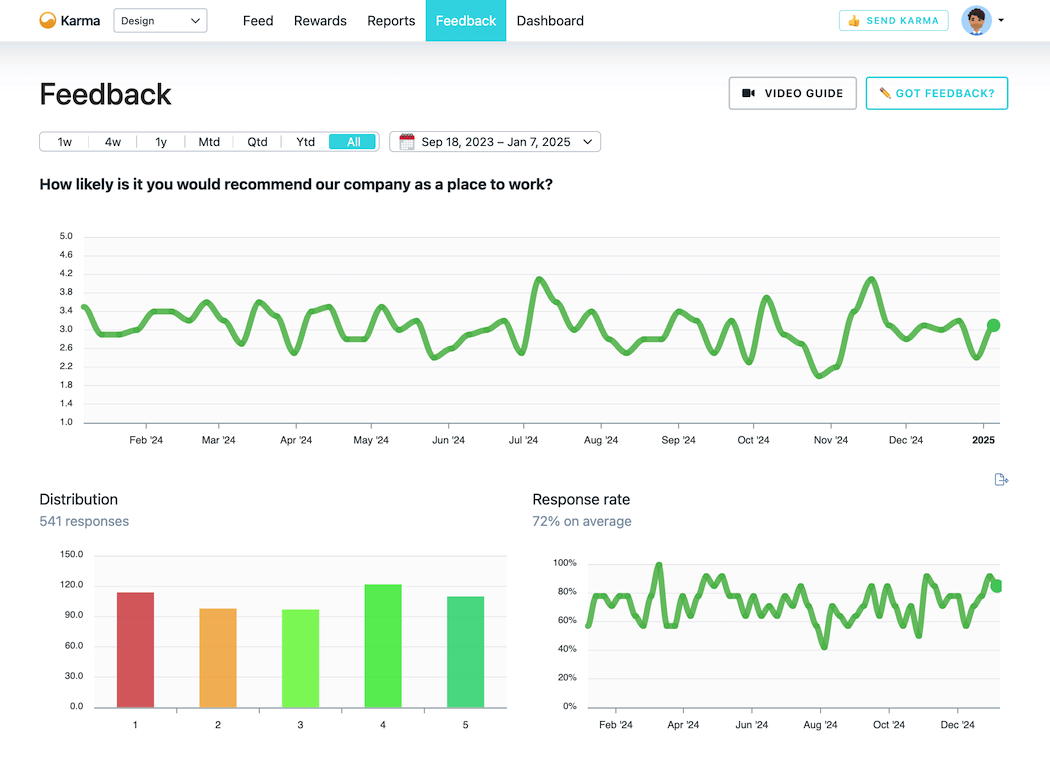Employee recognition programs are essential for fostering a positive workplace culture, boosting morale, and increasing productivity. Yet, many companies struggle to make these programs truly effective. One of the most powerful ways to ensure your recognition initiatives resonate with employees is through direct feedback. By actively listening to employees and refining recognition efforts accordingly, businesses can create programs that are both meaningful and motivating.
Why Employee Feedback Matters in Recognition Programs
Recognition should never be a one-size-fits-all approach. Employees have unique preferences when it comes to how they want to be acknowledged. Some may prefer public recognition, while others value a private message or tangible rewards. Without feedback, companies risk implementing programs that miss the mark, leading to disengagement instead of motivation.
Research supports this: 79% of employees who quit their jobs cite a lack of appreciation as a key reason for leaving (O.C. Tanner Institute). Additionally, a Gallup survey found that employees who feel recognized are 20 times more likely to be engaged at work. Despite these statistics, only one in three U.S. workers say they have received recognition for their work in the past week.
Gathering employee feedback ensures that recognition efforts align with their needs and preferences, ultimately leading to a stronger, more engaged workforce.
Methods for Collecting Employee Feedback
To improve recognition programs, companies must first establish channels to gather honest, actionable feedback. Here are some of the most effective methods:
1. Anonymous Surveys
Anonymous surveys provide employees with a safe space to share their opinions candidly. Questions should be direct and focus on the effectiveness, frequency, and preferred types of recognition. Sample questions include:
- How often do you feel recognized for your work?
- Do you prefer public or private recognition?
- What type of rewards do you find most meaningful?
- What can we do to improve our recognition program?
Using a mix of multiple-choice, Likert scale, and open-ended questions allows for both quantitative and qualitative insights.
2. One-on-One Check-Ins
Regular one-on-one meetings with managers provide an opportunity for employees to express their thoughts on recognition in a more personal setting. These conversations help managers tailor their appreciation efforts to individual team members while also collecting valuable feedback on company-wide initiatives.
3. Focus Groups
Bringing together a small group of employees from different departments to discuss recognition programs can uncover deeper insights. Employees can bounce ideas off each other, and HR teams can gauge common themes in their feedback.
4. Employee Engagement Platforms
Technology-driven feedback solutions, like Slack-integrated recognition tools, make it easier for employees to provide real-time input. Karma’s Anonymous Feedback feature, for example, allows employees to share their thoughts without fear of judgment, ensuring honest and constructive feedback that can help improve recognition programs.
Analyzing and Implementing Feedback
Once you’ve gathered feedback, the next step is to analyze the data and take action. Here’s how:
1. Identify Trends
Look for common themes in employee responses. Are employees saying they don’t feel recognized enough? Do they prefer peer-to-peer recognition over manager-driven programs? Understanding these patterns helps prioritize changes that will have the most impact.
2. Address Areas of Improvement
If employees indicate that they prefer a different recognition method, act on that information. For example, if the majority favor personalized messages over public shout-outs, encourage managers to shift their approach accordingly.
3. Test and Iterate
Recognition programs should be dynamic, not static. Implement changes based on feedback, then measure their effectiveness through follow-up surveys and engagement metrics. Continue refining the program based on new insights.
4. Communicate Changes
Transparency is crucial. Once feedback is collected and acted upon, inform employees about what’s changing and why. This not only builds trust but also encourages further participation in feedback initiatives.
Best Practices for an Effective Recognition Program
To maximize the impact of your employee recognition program, consider the following best practices:
1. Make Recognition Timely and Specific
Recognizing employees promptly after an achievement ensures the appreciation feels genuine and meaningful. Vague praise like “Good job!” is less impactful than specific acknowledgment such as, “Your presentation on Q4 sales strategies was incredibly insightful and helped us secure a major client.”
2. Balance Public and Private Recognition
While some employees thrive on public praise, others may feel uncomfortable with the spotlight. Offering a mix of public (team meetings, Slack announcements) and private (personal messages, emails) recognition ensures everyone feels valued in a way that suits them best.
3. Encourage Peer-to-Peer Recognition
Recognition shouldn’t always come from the top. Encouraging employees to recognize their peers fosters a more collaborative and appreciative workplace. According to a report by SHRM, peer-to-peer recognition makes employees 35% more likely to feel engaged at work.
4. Offer Meaningful Rewards
Generic rewards like gift cards are appreciated but may not be the most effective motivator. Consider offering a choice of rewards, such as extra time off, personalized gifts, or professional development opportunities.
5. Leverage Technology for Seamless Recognition
Recognition tools integrated with workplace platforms (such as Slack) make it easier to celebrate achievements in real-time, as they allow for instant kudos, and anonymous feedback to refine the program continuously.
The Role of Anonymous Feedback in Recognition Programs
Employees may hesitate to provide honest feedback due to fear of repercussions. This is where anonymous feedback tools become invaluable. With Karma’s Anonymous Feedback feature in Slack, employees can share their thoughts without attaching their names, leading to more truthful and constructive input.
Anonymous feedback allows HR teams and leadership to uncover hidden gaps in recognition programs, address concerns proactively, and implement meaningful improvements.

Final Thoughts
Employee feedback is a game-changer when it comes to building a recognition program that truly works. By actively collecting, analyzing, and implementing feedback, companies can foster a culture where employees feel genuinely valued and motivated.
Recognition isn’t just about saying “thank you” – it’s about showing employees that their contributions matter in a way that resonates with them. By leveraging employee insights and tools like Karma, companies can create recognition programs that drive engagement, retention, and overall workplace happiness.
Try out Karma for Slack with our demo and subscribe to your 30-day free trial:


 How to Recognize Employees Without Breaking the Budget
How to Recognize Employees Without Breaking the Budget